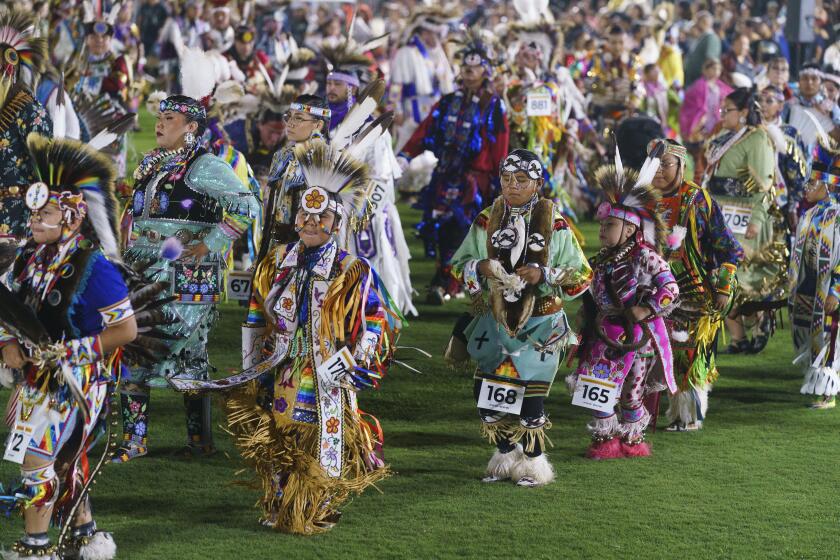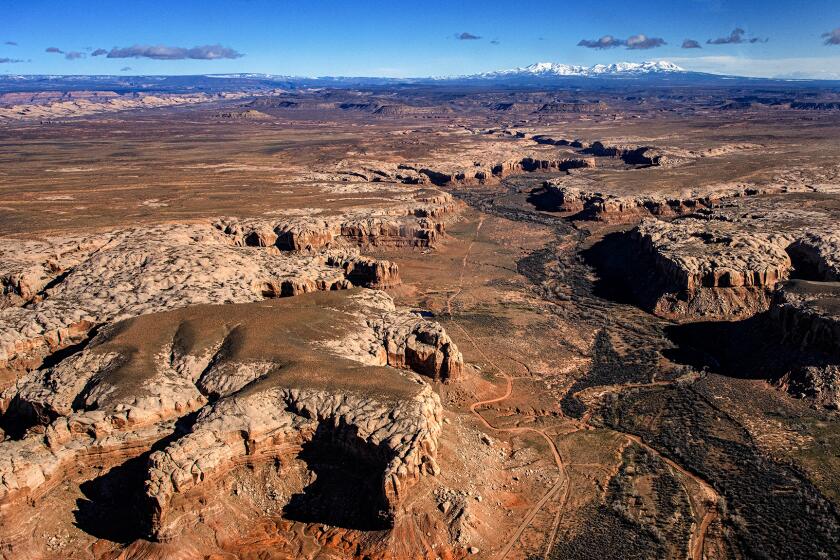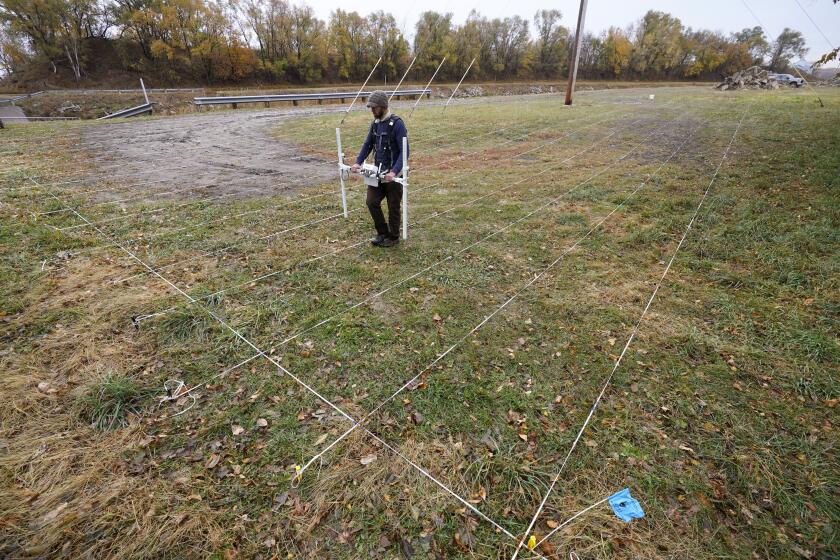A book that revealed the ‘entire story’ of Indian boarding schools would be important. This isn’t it.

- Share via
Book Review
The Plot against Native America: The Fateful Story of Native American Boarding Schools and the Theft of Tribal Lands
By Bill Vaughn
Pegasus Books, 256 pages, $29.95
If you buy books linked on our site, The Times may earn a commission from Bookshop.org, whose fees support independent bookstores.
In November 2000, the Heard Museum in Phoenix opened a groundbreaking exhibition, “Remembering our Indian School Days: The Boarding School Experience.” The show, so popular that an updated version remains on view, showcased the voices of Native American children sent away to federally run boarding schools designed to eradicate their cultural heritage and assimilate them to white society.
Uprooted from their communities, they were subjected to miserable living conditions, military-style regimentation, religious conversion, forced labor and traumatizing physical and sexual abuse. Students were punished harshly simply for speaking their own language. Some ran away. Many died of disease, and their bodies frequently were not returned to their families.

In both the United States and Canada, reverberations of this 19th and 20th century tragedy are still being felt. Apologies and investigative reports have proliferated. Lawsuits over reparations and battles over the exhumation of the schools’ mass graves continue.
San Diego County’s San Luis Rey Band of Mission Indians is one of a number of tribes in the state that are still fighting for federal acknowledgment.
Bill Vaughn’s “The Plot Against Native America,” which plays on a Philip Roth title, bills itself as “the first narrative history revealing the entire story” of these boarding schools. That would make it an important book — if only its narrative weren’t such an odd, disjointed mess.
Vaughn is on the right side of history. And though not Native American, he has a personal stake in the events he relates. His great-grandfather served as a caretaker at St. Peter’s Mission, a boarding school in Montana, and his grandfather and mother were born there. But however well-intentioned, his book badly needed an editor to nudge his anecdotes and digressions toward coherence.
To an astonishing extent, Vaughn jumps around in time and space, bouncing across the centuries and wandering as far afield as Paraguay. Perhaps he was drawing inspiration, however ham-handedly, from the nonlinear world views of Native American cultures, many of which see time as circular. More likely he was simply free associating.

Another problem, perhaps the central one, is that Vaughn seems unclear on the bounds of his subject. A better book might have focused more tightly on the boarding school saga, including its context and legacy. Vaughn does interweave stories of some boarding school children, including Nancy Bird, a multilingual Métis (mixed race) girl from Montana’s Blackfeet Indian Reservation and a student at both St. Peter’s and the Carlisle Indian Industrial School in Pennsylvania. Elsewhere, he offers harrowing accounts of physical and sexual abuse.
Too often, though, Vaughn detours into the larger tragedy of U.S. colonization, with its fallout of war, disease and land theft, as well as the cultural destruction embodied by the boarding schools.
He touches on the modern-day activism of the American Indian Movement, including the occupations of Wounded Knee and Alcatraz; the Dakota Access Pipeline protests; the reflorescence of endangered Native American languages, and successful efforts to expose the massive corruption of the U.S. Bureau of Indian Affairs. One of his heroes is MacArthur Foundation fellow Elouise Pepion Cobell, a member of the Blackfeet Nation who trained her accountant’s eye on the bureau’s mismanagement of Native American trust funds.
A conservation group hopes to turn a newly purchased Utah ranch into a model for working with tribes to protect wilderness in the American West from real estate developers, mining companies and oil drillers.
But at most Vaughn can offer only a scattershot portrait of the perils and aftershocks of colonization, stories already told elsewhere. His inability to resist a colorful anecdote, however tangential, is evident in his discussion of Gen. George Armstrong Custer and the Battle of the Little Bighorn. Vaughn details the post-battle mutilation of Custer’s corpse, with sewing awls and an arrow, in ways too grisly to repeat here. He dismisses Christopher Columbus, once hailed as the discoverer of the Americas, as “this murderous slave-trader.”
One key point Vaughn makes is that not all Indian boarding schools were created equal. He draws a distinction between Catholic boarding schools, operated by Jesuits, Franciscans, Ursulines and other orders, and schools directly under the purview of the U.S. government. The latter were often run by Protestant evangelicals, who also operated boarding schools of their own.
The Catholic Church, Vaughn suggests, was more interested in religious conversion than in other aspects of assimilation. As a result, its schools, at least initially, were more tolerant of Native languages and customs. For that reason, some tribal parents, eager for their children to receive an education, voluntarily enrolled them.
Archeologists are digging in a central Nebraska field to find the bodies of more than 80 children who were buried at a Native American boarding school.
After a while, the distinctions blurred. The Catholic schools, including St. Peter’s, also imposed dire living conditions and strict rules, and they were often beset by abuse. One of Vaughn’s many villains is Katharine Drexel, a wealthy nun from Philadelphia whose fortune helped sustain the Catholic boarding schools after the federal government, in the late 19th century, began phasing out its financial support.
Another important character is Richard Henry Pratt, who headed Carlisle, the first and perhaps best known of the federal boarding schools. Pratt was both an ardent evangelical Protestant and an assimilationist, and Carlisle, founded in 1879 and shuttered in 1918, was a grim place. But though his methods were wrong-headed and brutal, Pratt arguably did care about his charges. He wanted, he said, “to lift up the Indian Race,” and opposed both segregation of Blacks in the Army, and of Indians on reservations.
Given Vaughn’s personal connection to the boarding school story, one can interpret “The Plot Against Native America” as his modest attempt at reparations. But like so many other such efforts, it falls dramatically short.
Julia M. Klein is a cultural reporter and critic in Philadelphia.
More to Read
A cure for the common opinion
Get thought-provoking perspectives with our weekly newsletter.
You may occasionally receive promotional content from the Los Angeles Times.













